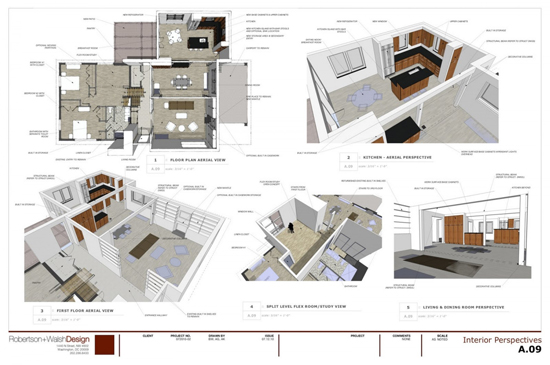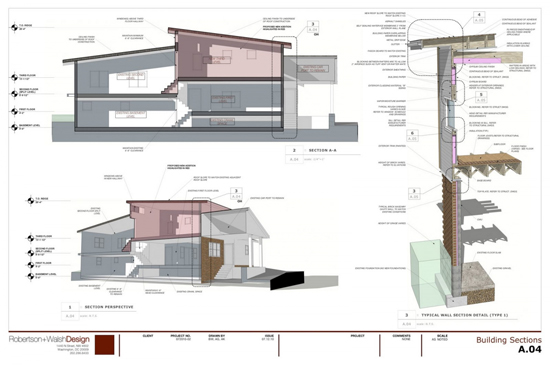Performance Matters!
Final Design and Construction Documentation
Designs that are optimized using 3-D computer models with PBD may require significantly less additional analysis in the final design and construction documents phases than typical designs. While some performance goals will always require predictive analysis to be performed in the final stages of design, or even after CDs are complete, PBD projects have already benefitted from comparative optimizations well before these late stages.
What is typically most important at this point is to be sure that the final construction documents show the same building materials and systems as those modeled for performance. Fortunately, 3-D computer model programs typically make it very straightforward to extract floor plans, sections, schedules, details, and other common construction documents directly from the model. Hence, if set up correctly, all of the relevant information can simply be transferred directly to 2-D drawings without needing to re-create anything. Alternatively, in some cases, the entire model can be used by contractors for pricing and construction without the need for many 2-D representational drawings. Either way, the computer model also makes it very easy to create revisions, which may become necessary while PBD tools continue to provide feedback on the impact of those revisions.
In some cases, the construction drawings extracted from a 3-D computer model can retain some of their three-dimensional appearance to communicate more effectively the performance-based construction assemblies and details needed. For example, Brandon Walsh of Robertson Walsh Design provides some outstanding construction documents, all created first in 3-D computer models. Everyone involved recognizes that being able to see things in 3-D helps all team members, including clients, to better understand the form and organization of the building design, which in turn helps decisions get made quicker to keep things moving forward. The firm has been so pleased with the results that Walsh commented, “We’re going to throw CAD out the door! The process of labeling and dimensioning in the model software was far superior to CAD; was easier to see and faster to complete for us.” He also points out that any engineers the firm works with receive exports right from their model, meaning it works beautifully for collaboration.
In the end, it all comes down to developing one computer model that can be used to explore the design, analyze the performance of the building, produce all the construction drawings, and could even get used for information sharing within a firm or marketing to other clients.


Photo courtesy of SketchUp
Robertson Walsh Design uses computer models as the basis of construction drawings that communicate the design in both 2-D and 3-D images.
Conclusion
Three-dimensional computer modeling linked with performance-based design is rapidly transforming the design professions and the building industry. Hundreds of architecture and engineering firms are already implementing this process to create buildings that perform as intended while producing great designs that function well for owners and users. Today, these firms are using this combination to stay ahead of the demands of owners, meet increasingly higher standards for performance, and improve their own internal design and workflow processes. Tomorrow, it’s easy to imagine firms of all sizes will be using this approach just to stay current and competitive with everybody else.
Peter J. Arsenault, FAIA, NCARB, LEED AP is an architect and green building consultant who has authored over 100 continuing education and technical publications as part of a nationwide practice. www.linkedin.com/in/pjaarch

|
 |
Notice

www.sefaira.com

www.SketchUp.com








